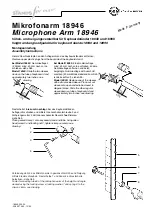
IP Src and IP Dest:
For IP Src, if the IP connection is up, refer to section 5.1 IP in the V100+ Common Functions
manual
. The source address is fixed to the IP address from the IP setup menu.
IP TOS (for Quality of Service testing):
Legacy TOS (Precedence):
The first three bits of the IP TOS field can be edited:
000 - Routine
001 - Priority
010 - Immediate
011 - Flash
100 - Flash Override
101 - Critical
110 - Internetwork Control
111 - Network Control
DSCP (Differentiated Services Code Point):
The first six bits of the IP TOS can be edited to provide more
granular service classification.
For more information on the definition of DSCP field in IPv4 and IPv6 headers, refer to
.
Time To Live (TTL):
Can be configured in the range 0 to 255.
Fragment offset byte:
Can be configured in the range 0 to 65.528.
Note:
The fragment offset field, measured in units of eight-byte blocks, is 13 bits long and specifies the offset
of a particular fragment relative to the beginning of the original unfragmented IP datagram.
Protocol field:
UDP (0x11), TCP (0x06), or User defined.
BERT Setup - IP Settings (DSCP
)
BERT Setup - IP Settings (Legacy TOS
)
Data Tab:
User selects a test pattern that will be encapsulated in the Ethernet frame payload (for framed mode).
Depending on the test layer, different test pattern options are available:
Layer 1 test patterns
CRPAT:
Compliant Random Pattern provides broad spectral content and minimal peaking for the
measurement of jitter at component or system level.
CJTPAT:
Compliant Jitter Test Pattern is a Jitter Tolerance Pattern that stresses a receiver by exposing it to
extreme phase jumps thereby stressing the Clock Data Recovery (CDR) circuitry. The pattern alternates
between repeating low transition density patterns and repeating high transition density patterns.
CSPAT:
Compliant Supply Noise Pattern. Represents worst case power supply noise.
BERT Setup - Test Pattern (Layer 1 Unframed
)
BERT Setup - Test Pattern (Layer 1 Framed
)
/ e_Manual D07-00-050P RevD00
Page 29 of 115
















































